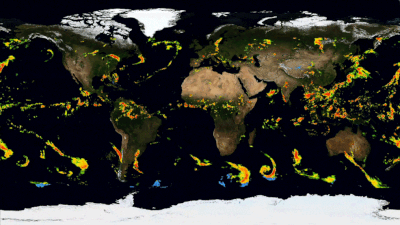What is El Niño?
This irregularly occurring weather phenomenon is created through an abnormality in wind and ocean circulation. When it originates in the equatorial Pacific Ocean. El Niño has wide-reaching effects. In a global context, it affects rainfall, ocean productivity, atmospheric gases, and winds across continents. At a local level, it influences water supplies, fishing industries, and food sources.
How Do We See El Niño?
Here are some of El Niño’s key impacts and how we study them from space:
Rainfall: El Niño often spurs a change in rainfall patterns that can lead to major flooding, landslides, and droughts across the globe.
How did NASA study it?
NASA Global Precipitation Measurement mission (GPM), tracks precipitation worldwide and creates global precipitation maps updated every half-hour using data from a host of satellites. Scientists can then use the data to study changes in rain and snow patterns. This gives us a better understanding of Earth’s climate and weather systems.
Hurricanes: El Niño also influences the formation of tropical storms. El Niño events are associated with fewer hurricanes in the Atlantic, but more hurricanes and typhoons in the Pacific.
How did NASA study it?
NASA has a suite of instruments in space that can study various aspects of storms, such as rainfall activity, cloud heights, surface wind speed, and ocean heat.
Ocean Ecology: While El Niño affects land, it also impacts the marine food web, which can be seen in the color of the ocean. The hue of the water is influenced by the presence of tiny plants, sediments, and colored dissolved organic material. During El Niño conditions, upwelling is suppressed and the deep, nutrient-rich waters aren’t able to reach the surface, causing less phytoplankton productivity. With less food, the fish population declines, severely affecting fishing industries.
How did NASA study it?
NASA satellites measure the color of the ocean to derive surface chlorophyll, a pigment in phytoplankton and observe lower total chlorophyll amounts during El Niño events in the equatorial Pacific Ocean.
Ozone: El Niño also influences ozone a compound that plays an important role in the Earth system and human health. When El Niño occurs, there is a substantial change in the major east-west tropical circulation, causing a significant redistribution of atmospheric gases like ozone.
How did NASA study it?
NASA Aura satellite is used to measure ozone concentrations in the upper layer of the atmosphere. With more than a decade of Aura data, researchers are able to separate the response of ozone concentrations to an El Niño from its response to change in human activity, such as manmade fires.
Fires: El Niño conditions shift patters of rainfall and fire across the tropics. During El Niño years, the number and intensity of fires increases, especially under drought conditions in regions accustomed to wet weather. These fires not only damage lands but also emit greenhouse gases that trap heat in the atmosphere and contribute to global warming.
How did NASA study it?
NASA MODIS instruments on Aqua and Terra satellites provide a global picture of fire activity. MODIS was specifically designed to observe fires, allowing scientists to discern flaming from smoldering burns.




0 Comments